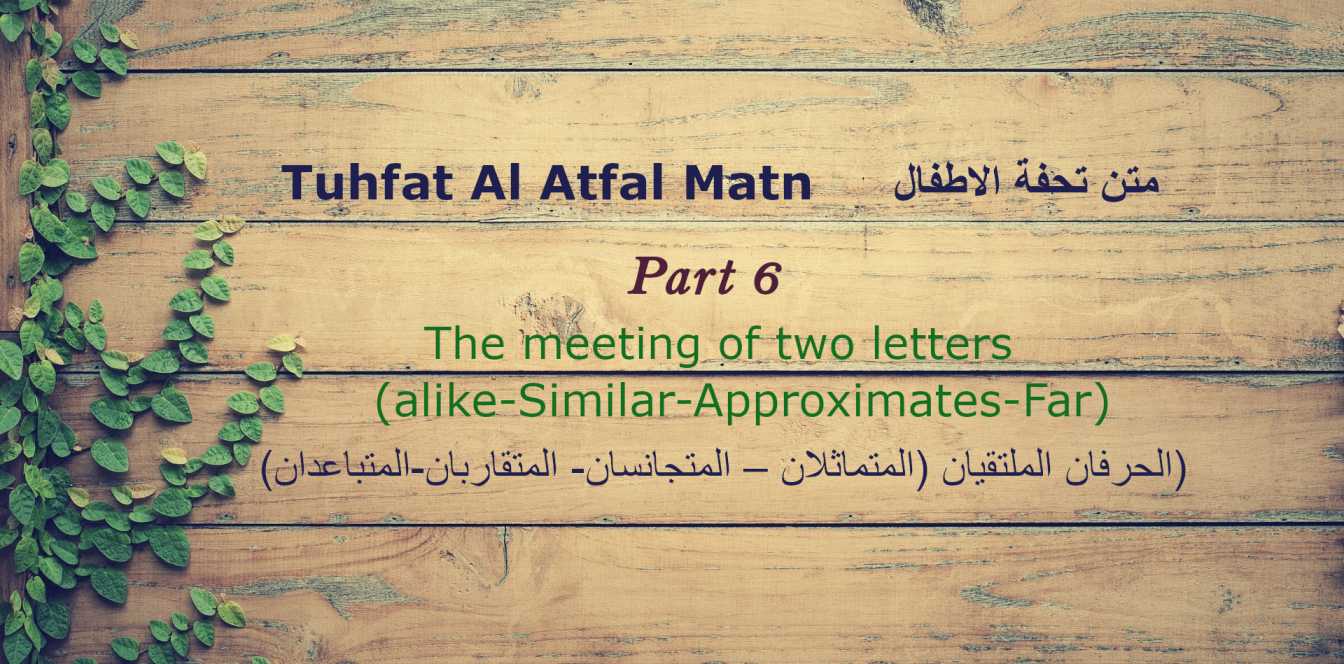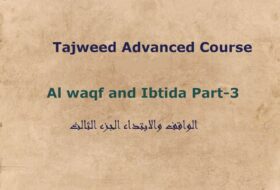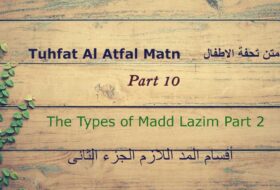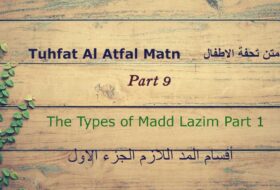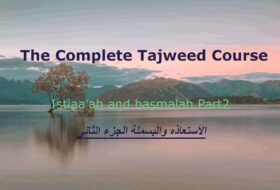The meeting of two letters (alike-Similar-Approximates-Far) (الحرفان الملتقيان (المتماثلان – المتجانسان- المتقاربان-المتباعدان
See Part 1 Part 2 Part3 Part-4 Part-5 Part-7 Part-8 Part-9 Part-10 Part-11
والمثلين والمتقاربين والمتجانسين
إِنْ فِـي الصَّفَــات وَالَمخارجِ اتَّفَـقْ حَرفَانِ فَالمثْلان فِيهمَــا أَحَـقّ
وَإنْ يَكُــونَا مَخْــرجاً تَقَـــارَباً وَفِي الصَّفّات اخْتَلَفَــا يُلَقَّبِــا
مُتَقَــارِبَيْنِ أَوْ يَكــُونَا اتَّفَقَـــا فِي مَخْرَجٍ دُونَ الصَّفَــاتِ حُقَّقَا
بالمُتَجَانِسَيْــنِ ثُــمَّ إنْ سَكَـــنْ أَوَّلُ كّــلًّ فَالصَّغِير سَمَّيَـــنْ
أَوْ حُــرَّكَ الحـــرَفَانِ فِي كُلًّ فَقُلْ كُــلٌّ كَبِيرٌ وَاْفْهَمَنْهُ بِالُمثُــلْ
Introduction:
This chapter deals with the relationship between two letters meeting. They will either be close to each other (have a lot in common – share the same makharij and/or sifat) or be distant from each other (not have a lot in common – and not share the same makharij and/or ṣifat).
The closeness between two letters is measured via their makhārij and ṣifat and has three basic levels:
- Mithlayn (this is the strongest/closest relationship any two letters can have)
- ) Mutajanisayn (this is a very strong/close relationship but is not as strong as number one)
- Mutaqaribayn (is a close relationship but it is weaker than the above two)
If the relationship between two letters is established as being close i.e. if any one of the above three relationships can be proven, then it will be a cause (Sabab) for idgham. Therefore the closer the letters, the stronger the reason to make idgham.
On the other hand, if none of the above three relationships can be established, the two letters will be considered distant (وبعد) from each other and will be read with iṭḥ-har.
In the following lines Jamzuri defines mithlayn, mutajanisayn and mutaqaribayn:
TEXT: 30
إِنْ فِـي الصَّفَــات وَالَمخارجِ اتَّفَـقْ حَرفَانِ فَالمثْلان فِيهمَــا أَحَـقّ
VOCABULARY:
اتَّفَـقْ – agree
حَرفَانِ – letters two
فَالمثْلان – then (the two letters) will be mithlayn
فِيهمَــا – in the two letters
أَحَـقّ – more rightful, more befitting
TRANSLATION:
30. If in Sifat and Makharij two letters agree, then it is more befitting that they (the two letters) be Mithlayn.
COMMENTARY:
In this line the author defines Mithlayn: two letters which agree in makhraj and Sifat. Thus any two letters which are pronounced from the same Makhraj and share matching Sifat are Mithlayn (identical/equivalent) e.g. the two meems in لَهُم مَّا and الرَّحِيمِ (3) مَالِكِ or the two bas in اضْرِب بِّعَصَاكَ and بِالْأَلْقَابِ ۖ بِئْسَ
As can be seen in the above examples that any two identical letters are in fact mithlayn.

TEXT: 31
وَإنْ يَكُــونَا مَخْــرجاً تَقَـــارَباً وَفِي الصَّفّات اخْتَلَفَــا يُلَقَّبِــا
VOCABULARY:
وَإنْ يَكُــونَا – if they (the two letters) are
مَخْــرجاً – makhraj in
تَقَـــارَباً – they (the two letters) are close
اخْتَلَفَــا – they (the two letters) differ
يُلَقَّبِــا – they (they two letters) are named
TRANSLATION:
31. And if they (the two letters) are close in makhraj, and in Sifat they differ, then they are called mutaqaribayn.
COMMENTARY:
In this line the author explains what mutaqaribain is. Any two letters which are close in makhraj and have different sifat would be considered mutaqaribayn e.g. the lām and raʾ in وَقُل رَّبِّ and قَالَ رَبِّ or the qaf and kāf in وَخَلَقَ كُلَّ or أَلَمْ نَخْلُقكُّم
In the first two examples, the lam and raʾ are close in makhraj since they are only separated by the noon, and the Raʾ is different to the lam in sifat due to it having takrir. In the second example, the qaf is close to the kaf because they are both pronounced from the back portion of the tongue, and are different in sifat due to the qaf having jahr, istiʿlaʾ and qalqalah, which the kaf does not have.
TEXT: 32
مُتَقَــارِبَيْنِ أَوْ يَكــُونَا اتَّفَقَـــا فِي مَخْرَجٍ دُونَ الصَّفَــاتِ حُقَّقَا
VOCABULARY:
أَوْ – or
اتَّفَقَـــا – they (the two letters) agree
دُونَ – ُbut not
حُقَّقَا – ُthey (the two letters) are confirmed. It may also be read as حُقَّقَا meaning, confirm them (being an imperative
TRANSLATION:
32. Or they (the two letters) agree in makhraj but not in Sifat, then they are confirmed/confirm them as mutajānisayn.
COMMENTARY:
If the two letters have the same makhraj but they differ in Sifat, they will be mutajanisayn e.g. the taaʾ and the ṭaaʾ in وَقالَتْ طائِفَةٌ and الصَّالِحَاتِ طُوبَىٰ or the baʾ and the meem in ارْكَب مَّعَنَا and وَيُعَذِّبُ مَن يَشَاءُ .
In the first two examples, the taaʾ and the ṭaaʾ come from the same makhraj but the have different Sifat due to the ṭāʾ having shiddah, jahr, istiʿlaʾ, iṭbaq and qalqalah, whereas the taʾ will only share shiddah with the ṭaaʾ. In the latter two examples, the baaʾ and the mim have the same makhraj but different Sifat since the bāʾ has jahr, shiddah and qalqalah, whereas the mīm will have hams, tawassuṭ and no qalaqalah.
TEXT: 33
بالمُتَجَانِسَيْــنِ ثُــمَّ إنْ سَكَـــنْ أَوَّلُ كّــلًّ فَالصَّغِير سَمَّيَـــنْ
VOCABULARY:
أَوَّلُ – firstَ
كّــلًّ – ُُof each/all (the previously mentioned groups-mithlain, mutajanisain and mutaqaribain)
فَالصَّغِير – then small/minor.
سَمَّيَـــنْ– be sure to name it.
TRANSLATION:
33. Then if the first of each (of the above-mentioned groups) has a sukun, then be sure to name it minor (idgham).
COMMENTARY:
After explaining what mithlayn, Mutajanisayn and Mutaqaribayn is, the author divides all three groups into two types: Saghir(minor) and kabīr (major). In this line he explains the Saghir; if in any of the above groups the first letter is sakin then it will be Saghir.
In light of the above examples it will be the two Meems in لَهُمْ مَا the two ba`s in اضْرِب بِّعَصَاكَ the lam and the ra in وَقُل رَّبِّ the qaf and the kaf in أَلَمْ نَخْلُقكُّم the taʾ and ṭaʾ in وَقالَتْ طائِفَةٌ and the the ba and the Meem in ارْكَب مَّعَنَا
In the next line he explains kabir:
TEXT: 34
أَوْ حُــرَّكَ الحـــرَفَانِ فِي كُلًّ فَقُلْ كُــلٌّ كَبِيرٌ وَاْفْهَمَنْهُ بِالُمثُــلْ
VOCABULARY:
حُــرَّكَ – have a ḥarakah
الحـــرَفَانِ – two letters
فَقُلْ – then say
كَبِيرٌ – big/major
وَاْفْهَمَنْهُ – this understand
بِالُمثُــلْ – َِWith examples
TRANSLATION:
34. Or the two letters have a ḥarakah in each (of these three groups), then say all (of them) are major (idgham) and understand it with examples.
COMMENTARY:
If in any of the three groups, mithlayn, mutajanisayn or mutaqaribayn both letters have ḥarakat, then they will be kabeer.
In light of the above examples, it would be the two meems in الرَّحِيمِ مَالِكِ the two ba`s in بِالأَلْقَابِ بِئْس he lam and the raʾ in وَقُل رَّبِّ the qaf and the kaf in وَخَلَقَ كُلَّ شَيْءٍ in ṭشʾ the and taʾ th الصَّالِحَاتِ طُوبَىٰ
The summary of the last two lines is: if the first letter is sākin and idghām takes place in any of the above groups, it will be idghām Saghir. If both letters are mutaḥarrik and idgham takes place, then
it will be idgham kabeer. As the author suggests, it should be understood with examples. Sufficient examples have been given to make the student bunderstand this section.
ijazah-course-online
learn-quran-with-tajweed
the-mudood-lengthenings-part-1

